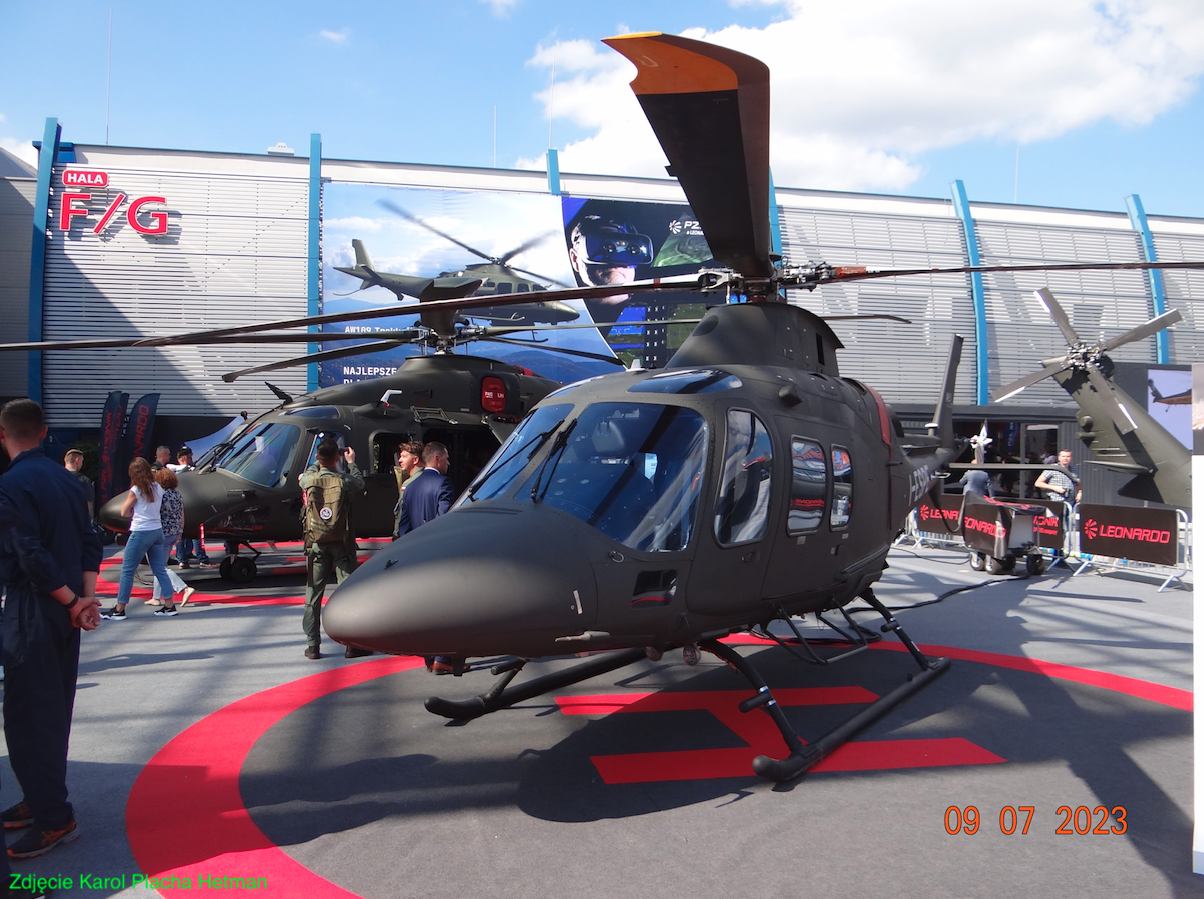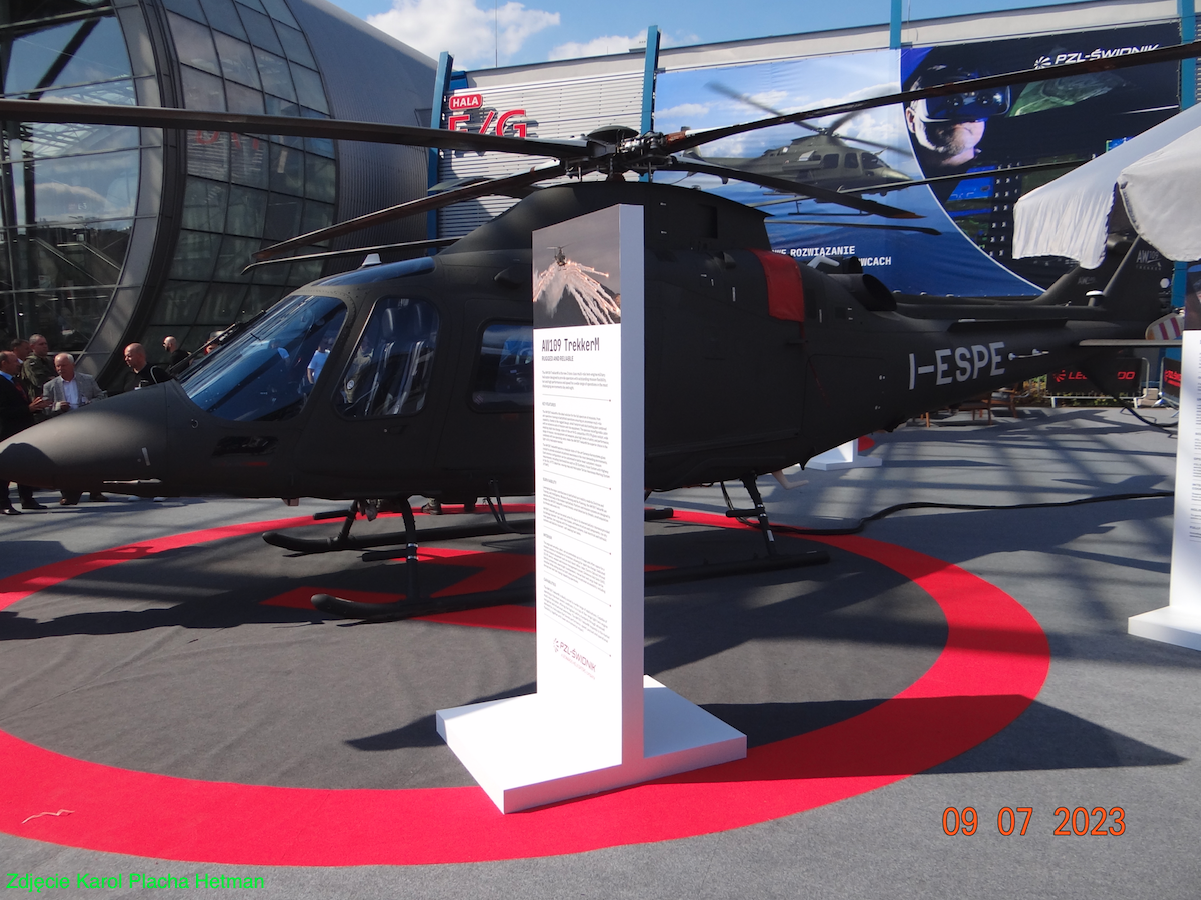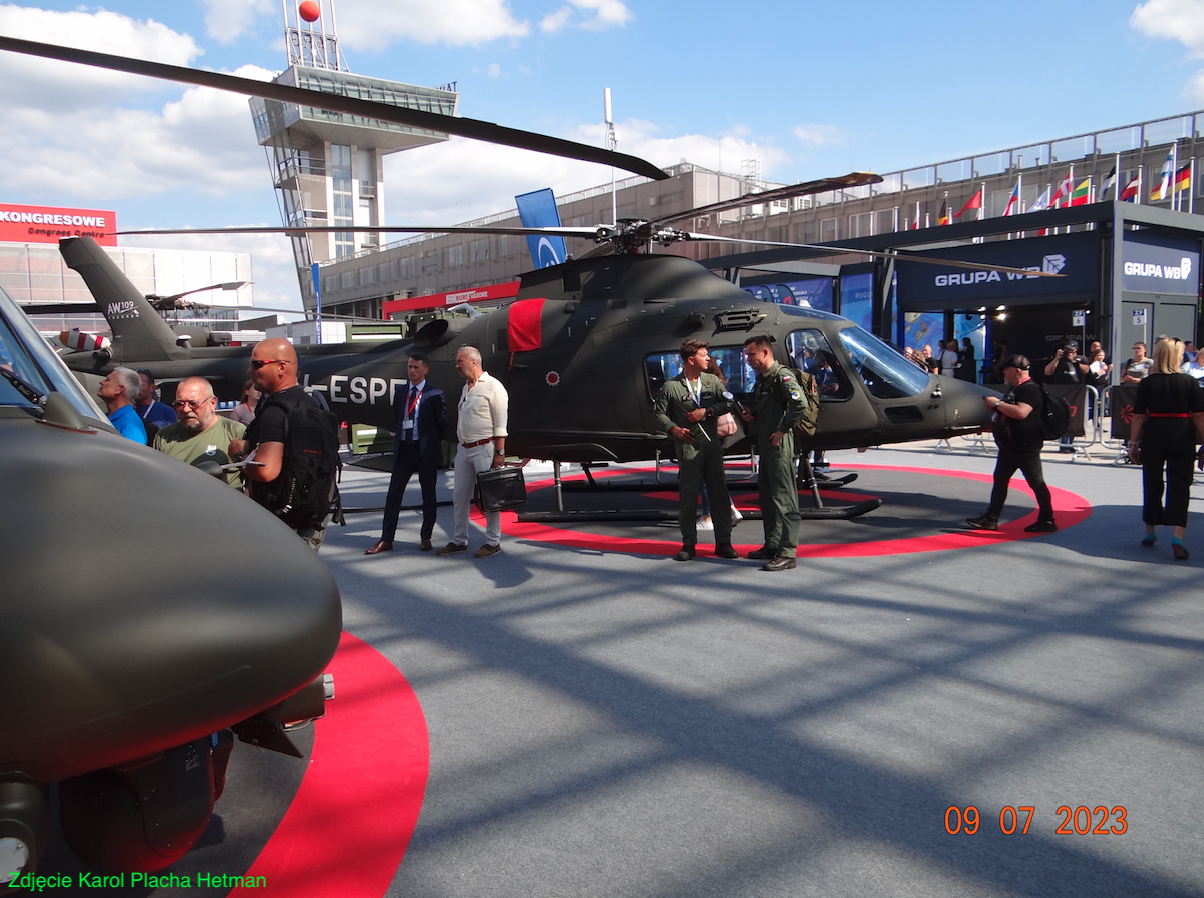Kielce 2023-09-12
PZL Świdnik Agusta AW.109 Trekker.
Śmigłowiec AW-109 Trekker to jest kolejna już generacja dobrego śmigłowca wielozadaniowego, którego początki sięgają 1971 roku. W dniu 4 sierpnia 1971 roku, pierwszy lot wykonał śmigłowiec A-109.
Śmigłowiec A.109 to jedyna własna konstrukcja firmy Agusta, obecnie (2023 rok) Leonardo. Prototyp A.109 nb NC 7101 pierwszy lot wykonał w dniu 4 sierpnia 1971 roku. Świadectwa RAI i FAA śmigłowiec uzyskał w dniu 1 czerwca 1975 roku. Jednocześnie śmigłowiec A.109 został dopuszczony do lotów według przyrządów z jedno-osobową załogą. Kilka miesięcy później śmigłowiec A.109 uzyskał certyfikaty: Francja, Kanada, RFN, Szwecja, Szwajcaria i UK.
Firma Agusta zaoferowała śmigłowiec A.109 w wersjach: cywilna, wojsk lądowych, lotnictwa morskiego. Śmigłowiec w wersji cywilnej był oferowany jako szybki transport VIP, a także dla służb państwowych: sanitarny, policyjny, straży granicznej.
Pierwsze seryjne śmigłowce dostarczono odbiorcom z początkiem 1976 roku. Ponad połowę produkcji śmigłowców wyeksportowano do USA. We Włoszech, śmigłowce A.109 trafiły do policji drogowej oraz do karabinierów. Dużo śmigłowców dostarczono do Afryki i Azji. Z początkiem 80-lat XX wieku, śmigłowiec A.109 poddano modernizacji. W kolejnych latach śmigłowiec modernizowano do zmieniających się potrzeb klientów. Śmigłowiec był i jest oferowany albo z podwoziem kołowym, które jest chowane, albo z podwoziem – płozy. Śmigłowiec A.109 K to wersja przeznaczona dla wojska, przystosowana do działania w gorącym klimacie. Prototyp A.109 K pierwszy lot wykonała w marcu 1983 roku. Śmigłowiec A.109 X Mk II Widebody ma powiększony kadłub, który jest szerszy. Śmigłowiec pierwszy lot wykonał we wrześniu 1984 roku.
W 90-latach XX wieku, firma WSK PZL Świdnik szukając zamówień, aby nie doprowadzić do likwidacji zakładu, w 1996 roku, zawarła umowę z firmą Agusta na produkcję w Świdniku elementów strukturalnych śmigłowców Agusta A.109 (obecnie AgustaWestland AW.109). W Świdniku rozpoczęto produkcję kadłubów i belek ogonowych śmigłowca. W 2006 roku, ze Świdnika dostarczono pięćsetny kadłub A.109. W 2001 roku, współpracę rozszerzono, o produkcję kadłuba do modelu Agusta A.119 Koala (obecnie AgustaWestland AW.119). Świdnik miał duży udział w projektowaniu i produkcji AgustaWestland AW.139. Od 2012 roku, w Świdniku powstają kompletne kadłuby do modelu AW.139. W tym czasie toczono także rozmowy o produkcji elementów dla śmigłowca AW.149, gdyby jego produkcja została podjęta.
AW-109 Trekker.
Śmigłowiec AW-109 Trekker to jest kolejna generacja śmigłowca A-109. Dzięki najlepszemu w swojej klasie udźwigowi, największemu zasięgowi i doskonałym osiągom, wielozadaniowy AW-109 Trekker umożliwia operatorom realizację nawet najbardziej wymagających zadań. Dwusilnikowy AW-109 Trekker to elastyczny, wytrzymały i niezawodny śmigłowiec zapewniający dużą ładowność i przestronną kabinę, którą można szybko przekonfigurować, dzięki czemu idealnie nadaje się do szerokiego zakresu zastosowań. Najwieksza w swojej klasie ładowność i osiągi śmigłowca AW-109 Trekker sprawiają, że idealnie nadaje się on do misji ratownictwa medycznego (EMS) oraz poszukiwawczo-ratowniczych (SAR). Doskonałe osiągi w klasie 1 kategorii A zapewniają śmigłowcowi bezpieczny start i lądowanie na zamkniętych przestrzeniach oraz możliwość szybkiego reagowania na zdarzenia. W wersji sanitarnej (medycznej), przestronna kabina umożliwia sprawną opiekę nad poszkodowanymi pacjentami na pokładzie.
W śmigłowcu zastosowano kabinę załogi w systemie glass-cokpit, firmy Genesys Aerosystems. System minimalizuje obciążenie pilota i zwiększa jego świadomość sytuacyjną. Duży zapasy mocy układu napędowego i pełna odporność na zderzenia, maksymalizują bezpieczeństwo w każdych warunkach lotu.
Nazwa angielska Trekker oznacza Wędrowiec. Projekt śmigłowca zaprezentowano w 2014 roku. Śmigłowiec został zaprezentowany na targach HeliExpo 2014 roku w Anaheim w Kalifornii, USA. Prototyp pierwszy lot wykonał w dniu 3 marca 2016 roku. Certyfikację AW-109 Trekker przeprowadzono w 2014 roku, a produkcję rozpoczęto w 2015 roku.
Śmigłowiec jest polowany przez jednego lub dwóch pilotów. Ładowania mieści do sześciu pasażerów lub dwóch pacjentów na noszach i trzy osoby dodatkowe. Śmigłowiec ma niski poziom wibracji i niski poziom hałasu, co zapewnia wysoki komfort pasażerom i załodze.
W konstrukcji śmigłowca postanowiono zastosować podwozie płozowe, które w porównaniu z chowanym podwoziem kołowym ma kilka ważnych zalet. Konstrukcja nowego śmigłowca oparta jest na konstrukcji AW-109 Grand. Całkowite przebudowano układ paliwowy, który jest odporny na wypadki i katastrofy. Śmigłowiec może być wyposażony w hak ładunkowy, o udźwigu 1 400 kg. Można także zamontować wyciągarkę ratowniczą, o udźwigu 272 kg. Śmigłowiec można wyposażyć w: radar, czujniki podczerwieni, dodatkowe reflektory szperacze, pływaki ratunkowe, głowice optoelektroniczne i inne.
AW-109 Trekker zawiera nowoczesny szklany kokpit Garmin G1000HTM, który jest przeznaczony do obsługi przez jednego pilota. W kokpicie znajdują się dwa wyświetlacze o przekątnej 10,4 cala, główny wyświetlacz lotu (PFD) i wyświetlacz wielofunkcyjny (MFD).
Ergonomicznie zaprojektowany kokpit, o wysokiej widoczności oferuje pilotom tylko niezbędne dane, minimalizując w ten sposób ich obciążenie pracą. Kokpit oferuje również opcję trzeciego ekranu, o przekątnej 10,4 cala, który może służyć jako PFD drugiego pilota.
Śmigłowiec jest wyposażony w technologię widzenia syntetycznego (SVT), technologię Highway In The Sky (HITS) oraz system rozpoznawania terenu i ostrzegania helikoptera (HTAWS), aby zapewnić pełną świadomość terenu i przeszkód w scenariuszu lotu przy słabej widoczności.
Śmigłowiec posiada trójosiowego autopilota, ruchomą mapę, system zarządzania lotem (FMS), dwa radia VHF/AM, podwójny OmniRange o bardzo wysokiej częstotliwości (VOR), podwójny globalny system pozycjonowania (GPS), elektroniczny system przyrządów rezerwowych (ESIS) ) i transponder Modu S. Trójwymiarowe naprowadzanie i szczegółowe mapy terenu dostarczane przez śmigłowiec poprawiają możliwości operacyjne wykonania zadania.
Śmigłowiec wyposażono w zespół napedowy złożony z dwóch silników firmy Pratt & Whitney Canada PW207C. Każdy turbinowy silnik generuje maksymalną moc 815 KM. Silniki są wyposażone w system Full Authority Digital Engine Control (FADEC).
Dane T-T AW-109 Trekker:
Długość całkowita 12,96 m 42 ft 06 in. Wysokość 3,60 m 11 ft 09 in. Średnica wirnika nośnego 10,83 m 35 ft 06 in. Średnica wirnika nośnego 10,83 m 35 ft 06 in. Prędkość maksymalna przelotowa 281 km/h 152 KTAS. Zasięg maksymalny 833 km 450 Mm. Maksymalny czas lotu 4 h 20 min. Maksymalna masa startowa (MTOW) 3 175 kg. Maksymalna masa startowa (zewnętrzny ładunek) 3 350 kg. Pojemność zbiornika paliwa (opcja 1) 670 litrów. Pojemność zbiornika paliwa (opcja 2) 806 litrów.
Opracował Karol Placha Hetman



